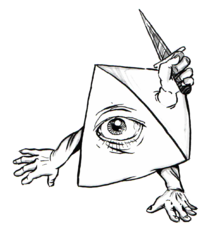- Modron (Dungeons & Dragons)
-
Modron Characteristics Alignment Lawful neutral (1st - 3,5 editions), Unaligned (4th edition) Type Outsider (3rd - 3,5 editions), Immortal animate (4th edition) Publication history First appearance Monster Manual II (1983) In the fictional multiverse of the Dungeons & Dragons fantasy role-playing game, Modrons are mechanical looking creatures native to the outer plane of Mechanus. Modrons resemble geometric shapes with humanoid limbs and represent a living, physical manifestation of law without regard to good or evil. They follow a strict hierarchy, with each rank reporting to the rank directly above it, and issuing commands to the ones ranking beneath it. For example, a quadrone modron will report to a pentadrone, and command several tridrones.
Publication history
Modrons were created by Jeff Grubb, working from suggestions by Gary Gygax.[citation needed] They first appeared in 1983, in the AD&D 1st edition Monster Manual II, which introduced the base modrons (including the monodrone, the duodrone, the tridrone, the quadrone, and the pentadrone), the hierarch modrons (including the decaton, the nonaton, the octon, the septon, the hexton, the quinton, the quarton, the tertian, and the secundus), and Primus (The One and the Prime).[1]
In the 2nd edition of Advanced Dungeons & Dragons, the Plane of Law was renamed Mechanus (instead of Nirvana) and the depiction of Modrons introduced clockwork features (expanding on the description of Nirvana as a plane of cogwheels in the 1st edition Manual of the Planes). The monodrone, the duodrone, the tridrone, the quadrone, the pentadrone, the decaton, the nonaton, the octon, the septon, the hexton, the quinton, the quarton, the tertian, the secundus, and Primus appeared in the Planescape Campaign Setting boxed set (1994).[2] In his review of the Planescape Campaign Setting boxed set, Gene Alloway mentioned the modrons as an example of "the old, tired and previously foolish" which the set "breathes new life and meaning into".[3] The Planescape Campaign Setting boxed set introduced the notion that modrons can only comprehend the existence of other modrons of one rank directly above or below them in their hierarchy. Only their immediate superiors and inferiors register in their minds - a modron is aware of the existence of all ranks below it, but communication is exclusively limited to adjacent ranks. Only Primus, the modron deity, is aware of all modrons, because he is at the top of the hierarchy.
Planescape also introduced rogue modrons: modrons who have left Mechanus and broken their connections to the other modrons.[2] Modrons were made a playable character race in The Planewalker's Handbook (1996),[4] and a rogue modron named Nordom (voiced by Dan Castellaneta) could join the player's party in the computer game Planescape: Torment.
In the 3rd edition of Dungeons & Dragons, modrons had largely faded from prominence, their place as the primary representatives of lawful neutrality taken by the antlike, expansionist formians and the robot-like, implacable Inevitables.[5] They have received only a passing reference in the Manual of the Planes sourcebook, with a more detailed explanation in the web enhancement.[6] In Dragon #354, an article was published on the recent history of the modrons, as well as detailed game statistics for the base modrons (the monodrone, the duodrone, the tridrone, the quadrone, and the pentadrone, as well as the messenger monodrone and the winged quadrone) and PC modrons such as the exiled modron.[7]
The 4th edition brought many changes to the cosmology of Dungeons & Dragons. In the article Creature Incarnations: Modrons in Dungeon #186, the Modrons are described as "cells" of the unknown being Primus. The monodrone brickguard, the duodrone marcher, the quadrone enforcer and the modron hierarch are described.[8]
Hierarchy
The hierarchy of Modrons, ranked from lowest to highest, is as follows:
Name Function Base Modrons Monodrone Basic tasks Duodrone Complex tasks Tridrone Many tasks, minor management Quadrone Many complex tasks, management Pentadrone Law enforcement Hierarch Modrons Decaton Base modron welfare Nonaton Law enforcement supervision Octon Sector governors Septon Inspection Hexton Generals Quinton Bureau chiefs, record keeping Quarton Region governors Tertian Judges Secundus Quarter governors Primus Supreme ruler of all modrons There are only limited numbers of hierarch Modrons in existence, there being only one Primus, four (two squared) Secundi, nine (three squared) Tertians, and so on. In order to keep this number stable, upon the demise of a Hierarch, one of a lower rank is promoted upwards, and the resulting void filled by another promotion, and so on. When the promotion reaches the Monodrone level, a new Monodrone is spawned from the Energy Pool in the center of Regulus to fill the void left by the promotion of a Monodrone into a Duodrone.
References
- ^ Gygax, Gary. Monster Manual II (TSR, 1983)
- ^ a b Cook, David "Zeb". Planescape Campaign Setting (TSR, 1994)
- ^ Alloway, Gene (May 1994). "Feature Review: Planescape". White Wolf (White Wolf) (43): 36–38.
- ^ Cook, Monte. The Planewalker's Handbook. (TSR, 1996)
- ^ Bart Carroll (January 26, 2011). "Modrons' March". D&D Alumni. Wizards of the Coast. http://www.wizards.com/DnD/Article.aspx?x=dnd/4alum/20110126#72711. Retrieved February 10, 2011.
- ^ Jindra, Mark. "Modrons Web enhancement". Manual of the Planes. Wizards of the Coast. http://www.wizards.com/default.asp?x=dnd/we/20010921a&pf=true. Retrieved 2007-02-01.
- ^ Marable, Ken. Return of the Modrons, Dragon #354 (Paizo, April 2007)
- ^ Bilsland, Greg; Bruce R. Cordell (27-01-2011). "Creature Incarnations: Modrons". Dungeon #186. Wizards of the Coast. http://www.wizards.com/dnd/Article.aspx?x=dnd/duci/201101modrons.
Categories:- Dungeons & Dragons extraplanar creatures
Wikimedia Foundation. 2010.

